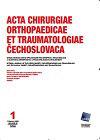拇指手掌骨关节不稳定:我们的手术结果。
IF 0.4
4区 医学
Q4 ORTHOPEDICS
Acta chirurgiae orthopaedicae et traumatologiae Cechoslovaca
Pub Date : 2023-02-15
DOI:10.55095/achot2023/004
引用次数: 0
摘要
研究目的:先天性关节活动过度患者在受伤后或由于关节负荷过大导致拇指关节的腕掌骨(CMC)不稳定。它们通常未被诊断,如果不及时治疗,是年轻人根腐病发展的基础。作者介绍了伊顿-利特勒技术的结果。材料与方法作者报告了2005-2017年间平均年龄为26.8岁(15-43岁)的53例CMC关节。10例患者出现创伤后状况,43例不稳定是由过度松弛引起的,其他关节也有这种情况。手术从Wagner改良的前桡骨入路进行。术后用石膏夹板固定6周,开始康复(磁疗、热身)。采用术前和术后36个月的VAS(休息时疼痛和运动时疼痛)、工作模块DASH评分、主观评价(无困难、不限制正常活动困难、限制正常活动困难)对患者进行评估。结果术前评估时,静息时平均VAS评分5.6,运动时平均VAS评分8.3。静息VAS评估时,术后6、12、24、36个月评分分别为5.6、2.9、0.9、1、2、1.1。在给定的负荷区间内进行评估时,检测值分别为4.1、2、2.2和2.4。工作模块DASH评分术前81.2分,术后6个月46.3分,12个月15.2分,24个月17.3分,36个月18.4分。在术后36个月进行的主观自我评估中,39例患者(74%)评估自己的病情没有困难,10例患者(19%)报告困难不限制正常活动,4例患者(7%)报告困难限制正常活动。大多数作者介绍了创伤后关节不稳定患者的手术结果,并报告了手术后2至6年的良好效果。有一个可以忽略不计的数量的研究解决不稳定患者的不稳定引起的多动。当使用作者在1973年描述的常规方法时,我们在手术后36个月进行的评估结果与其他作者报道的结果相当。我们很清楚,这是一个短期随访,这种方法并不能防止长期随访的情况下发生退行性变化,但减少了临床困难,并可能延缓年轻人严重根茎病的发展。结论:拇指关节CMC不稳定是一种相对常见的疾病,尽管并非所有个体都有临床困难。在困难的情况下,需要诊断和治疗不稳定性,因为这是如何在易感个体中预防早期根瘤病的发展。我们的结论提示手术解决的可能性和良好的结果。关键词:拇指掌关节,拇指CMC关节,拇指掌不稳,关节松弛,根状关节病。本文章由计算机程序翻译,如有差异,请以英文原文为准。
[Instabilities of the Thumb Carpometacarpal Joint: Our Surgical Outcomes].
PURPOSE OF THE STUDY Carpometacarpal (CMC) instabilities of the thumb joint occur after injuries or due to joint overload in patients with congenital joint hypermobility. They are often undiagnosed and, if left untreated, are the basis for the development of rhizarthrosis in young individuals. The authors present the results of the Eaton-Littler technique. MATERIAL AND METHODS The authors present a set of 53 CMC joints of patients with an average age of 26.8 years (15-43 years) operated on in the years 2005-2017. Post-traumatic conditions were found in 10 patients and in 43 cases instability was caused by hyperlaxity, also demonstrated in other joints. The operation was performed from the Wagner's modified anteroradial approach. After the operation, a plaster splint was applied for 6 weeks, after which rehabilitation (magnetotherapy, warm-up) began. Patients were evaluated using the VAS (pain at rest and during exercise), DASH score in the work module, and subjective evaluation (no difficulties, difficulties not limiting normal activities, and difficulties limiting normal activities) before surgery and 36 months after surgery. RESULTS During the preoperative assessment, the average VAS value was 5.6 at rest and 8.3 during exercise. During the VAS assessment at rest, the values at 6, 12, 24 and 36 months after surgery were 5.6, 2.9, 0.9, 1, 2 and 1.1. When evaluated in the given intervals under load, the detected values were 4.1, 2, 2.2 and 2.4. The DASH score in the work module was 81.2 before surgery, 46.3 at 6 months, 15.2 at 12 months, 17.3 at 24 months, and 18.4 at 36 months after surgery. In the subjective self-assessment made at 36 months after surgery, 39 patients (74%) assessed their condition as having no difficulties, ten patients (19%) reported difficulties that did not limit normal activities, and four patients (7%) reported difficulties limiting normal activities. DISCUSSION Most authors present the results of their surgeries in patients with post-traumatic joint instability, and they report excellent results at two to six years after surgery. There is a negligible number of studies addressing instabilities in patients with instability caused by hypermobility. When using the conventional method described by the authors in 1973, our results of the evaluation performed at 36 months after surgery are comparable to those reported by other authors. We are well aware of the fact that this is a short-term follow-up and that this method does not prevent developing degenerative changes in the case of long-term follow-up, but reduces clinical difficulties and may delay the development of severe rhizarthrosis in young individuals. CONCLUSIONS CMC instability of the thumb joint is a relatively common disorder, although not all individuals experience clinical difficulties. In the case of difficulties, the instability needs to be diagnosed and treated as this is how the development of early rhizarthrosis in the predisposed individuals can be prevented. Our conclusions suggest a possibility of a surgical solution with good results. Key words: carpometacarpal thumb joint, thumb CMC joint, carpometacarpal thumb instability, joint laxity, rhizarthrosis.
求助全文
通过发布文献求助,成功后即可免费获取论文全文。
去求助
来源期刊
CiteScore
0.70
自引率
25.00%
发文量
53
期刊介绍:
Editorial Board accepts for publication articles, reports from congresses, fellowships, book reviews, reports concerning activities of orthopaedic and other relating specialised societies, reports on anniversaries of outstanding personalities in orthopaedics and announcements of congresses and symposia being prepared. Articles include original papers, case reports and current concepts reviews and recently also instructional lectures.

 求助内容:
求助内容: 应助结果提醒方式:
应助结果提醒方式:


